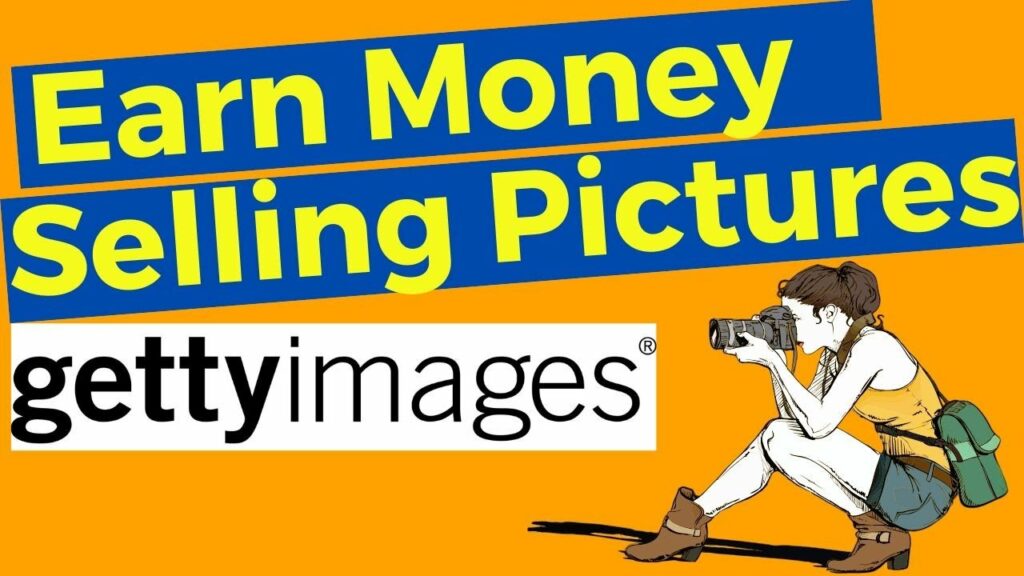Getty Images stands as a prominent figure in the realm of stock photography, recognized globally for its extensive collection of high-quality visual content. As a leading platform, Getty Images serves as a hub for both creators and consumers, facilitating the exchange of creative works across various industries and mediums.
In this blog post, we delve into an essential aspect of Getty Images: the earning potential it offers to contributors. While Getty Images provides a platform for users to access a vast library of images, it also presents an opportunity for photographers and artists to monetize their work by contributing to the platform.
Understanding the earning potential for contributors on Getty Images is paramount for those looking to leverage their creative talents into a source of income. Whether you're a seasoned professional or an aspiring photographer, grasping the intricacies of royalty rates, license types, and sales strategies can significantly impact your success on the platform.
Throughout this blog post, we'll explore various facets of earning potential on Getty Images, providing insights, tips, and practical advice to help contributors maximize their revenue and achieve financial success. From understanding royalty structures to implementing effective marketing strategies, we aim to equip contributors with the knowledge and tools needed to thrive in the competitive landscape of stock photography. So, let's embark on a journey to uncover the earning opportunities that await contributors on Getty Images.
How Earnings are Calculated:

Getty Images employs a royalty system to compensate contributors for the use of their images on the platform. Understanding this system is crucial for contributors to gauge their earning potential and make informed decisions about their contributions. Here's an overview of how earnings are calculated on Getty Images:
- Royalty System:
- Getty Images operates on a royalty-based model, where contributors earn a percentage of the revenue generated from the licensing of their images.
- Each time a customer licenses an image for use, a portion of the licensing fee is allocated to the contributor as royalties.
- Factors Influencing Earnings:
- Several factors influence the amount earned per image download or license sale:
- License Type: The type of license selected by the customer determines the usage rights granted and, consequently, the price and royalties earned.
- Image Size: Getty Images offers images in various sizes, each priced differently based on resolution and quality. Larger image sizes typically command higher prices and, subsequently, higher royalties.
- Exclusive vs. Non-Exclusive Content: Contributors may choose to offer their content exclusively to Getty Images or make it available through multiple agencies. Exclusive content often commands higher royalties.
- Volume of Sales: The frequency and volume of image downloads directly impact earnings. Popular or trending images are likely to generate more downloads and, therefore, higher royalties.
- Geographic Region: Royalty rates may vary based on the geographic region where the image is licensed. Certain regions may have different pricing structures or demand levels, affecting earnings.
- Several factors influence the amount earned per image download or license sale:
- Royalty Rates and Payment Structure:
- Getty Images offers varying royalty rates depending on factors such as license type, image size, and contributor status (exclusive vs. non-exclusive).
- Royalty rates typically range from 20% to 30% for still images and 25% to 45% for video content.
- Payments are made on a monthly basis, with contributors receiving their earnings via electronic funds transfer (EFT) or PayPal once they reach the payment threshold.
By understanding these factors and how they influence earnings, contributors can make informed decisions about their portfolio management, pricing strategies, and marketing efforts to maximize their revenue potential on Getty Images.
Also Read This: Estimating Earnings for 100K YouTube Views
Maximizing Earnings:

To unlock the full earning potential on Getty Images, contributors can implement strategic approaches tailored to attract buyers and optimize their portfolio. Here are some tips and strategies for maximizing earnings on the platform:
- Quality and Relevance:
- Focus on producing high-quality images that meet the technical standards and aesthetic preferences of buyers.
- Ensure that your content is relevant to current trends, themes, and topics in demand by commercial clients.
- Regularly review and update your portfolio to remove outdated or low-performing content and replace it with fresh, relevant material.
- Effective Keywording:
- Invest time in thorough and accurate keywording to enhance the discoverability of your images.
- Use descriptive and specific keywords relevant to the subject matter, composition, and context of each image.
- Incorporate both general and niche keywords to reach a broader audience while targeting specific buyer segments.
- Metadata Optimization:
- Pay attention to metadata elements such as titles, descriptions, and categories to provide additional context and information about your images.
- Optimize metadata to improve search engine visibility and increase the likelihood of your images appearing in relevant search results.
- Stay Updated on Trends:
- Keep abreast of current trends, events, and themes in the creative industry and adjust your content creation and marketing strategies accordingly.
- Anticipate seasonal demand for specific types of imagery (e.g., holidays, events, seasons) and tailor your portfolio to capitalize on these trends.
- Diversify Your Portfolio:
- Expand your portfolio to include a diverse range of subjects, styles, and formats to appeal to a broader audience.
- Experiment with different genres, concepts, and techniques to cater to diverse buyer preferences and increase your chances of attracting sales.
- Engage with the Community:
- Participate in forums, groups, and communities for Getty Images contributors to network, share insights, and learn from others in the industry.
- Collaborate with fellow contributors on joint projects, collaborations, or themed collections to leverage collective expertise and resources.
By implementing these tips and strategies, contributors can enhance their visibility, attract more buyers, and ultimately maximize their earnings on Getty Images. Consistent effort, attention to detail, and adaptation to market trends are key to success in the competitive world of stock photography.
Also Read This: Mastering Self-Marketing on LinkedIn
Understanding License Types:
Getty Images offers various license types to accommodate the diverse needs of its customers and contributors. Each license type grants specific rights and permissions for the use of images, influencing both the pricing and earning potential for contributors. Here's an overview of the different license types offered by Getty Images and their impact on earnings potential:
- Rights-Managed (RM) License:
- Rights-managed licenses provide customers with specific usage rights for a designated period and purpose.
- Pricing for rights-managed licenses is typically based on factors such as image size, intended use, duration, and geographic distribution.
- Contributors may earn higher royalties from rights-managed licenses due to the customized nature of the licensing agreements and the potential for premium pricing.
- Royalty-Free (RF) License:
- Royalty-free licenses grant customers broad usage rights with few restrictions, allowing for unlimited use of the image within the terms of the license.
- Royalty-free images are priced based on image size and resolution, with a one-time payment for usage rights.
- While royalty-free licenses may result in lower per-unit earnings for contributors compared to rights-managed licenses, they offer the potential for higher volume sales and broader distribution.
- Editorial Use License:
- Editorial use licenses are designed for non-commercial use in editorial contexts, such as newspapers, magazines, and online publications.
- These licenses restrict the use of images for editorial purposes only and may not be suitable for commercial or promotional use.
- Editorial use licenses may command lower prices compared to commercial licenses but offer the potential for exposure through widespread distribution in editorial publications.
Choosing the Right License Strategy:
- Contributors should consider their goals, preferences, and portfolio content when choosing a license strategy.
- Rights-managed licenses may be ideal for premium or exclusive content with limited distribution, offering the potential for higher earnings per license.
- Royalty-free licenses may be suitable for high-volume, commercially viable content that appeals to a broad audience, facilitating increased sales and revenue.
- Editorial use licenses can provide opportunities for exposure and recognition in editorial publications, complementing commercial licensing efforts.
By understanding the nuances of each license type and tailoring their licensing strategy to match their portfolio content and target audience, contributors can optimize their revenue potential on Getty Images while meeting the diverse needs of customers.
Also Read This: Highlights of the 2011 Royal Rumble Winner and Main Event
Real-Life Examples:
To provide actionable insights into achieving success on Getty Images, let's explore real-life examples of contributors who have excelled on the platform. These case studies offer valuable lessons and strategies for aspiring contributors looking to maximize their earnings and build a successful career in stock photography:
- Case Study 1: Jane Doe Photography
- Jane Doe is a freelance photographer who specializes in lifestyle and travel photography.
- Strategy: Jane consistently uploads high-quality images that capture authentic moments and evoke emotion. She focuses on niche topics within the lifestyle genre, such as wellness, outdoor activities, and cultural experiences.
- Portfolio Management: Jane regularly updates her portfolio with new content while maintaining a cohesive style and aesthetic. She pays attention to trends and customer preferences to ensure her portfolio remains relevant and competitive.
- Earnings Growth: Over time, Jane's earnings on Getty Images have steadily increased as she has expanded her portfolio and refined her marketing strategies. Her images resonate with buyers, leading to consistent sales and revenue growth.
- Case Study 2: John Smith Illustrations
- John Smith is an illustrator known for his vibrant and whimsical digital artwork.
- Strategy: John creates illustrations that cater to a wide range of industries and themes, including technology, business, education, and lifestyle. He leverages his unique artistic style to stand out in a competitive market and attract buyers.
- Portfolio Management: John diversifies his portfolio by offering a variety of illustration styles and subject matter. He regularly engages with customers and incorporates feedback to refine his work and meet evolving market demands.
- Earnings Growth: John's strategic approach to portfolio management and customer engagement has led to significant earnings growth on Getty Images. His illustrations are in high demand across various industries, resulting in consistent sales and increased revenue over time.
These real-life examples demonstrate that success on Getty Images is achievable through strategic portfolio management, consistent quality, and responsiveness to market trends. By following the lead of successful contributors like Jane and John, aspiring contributors can position themselves for growth and prosperity in the competitive world of stock photography.
Also Read This: Download YouTube Playlists for Free on PC and Manage Your Content
Tracking and Managing Earnings:
Effectively tracking and managing earnings is essential for Getty Images contributors to monitor their progress, optimize their strategies, and plan for financial stability. Here's a guide to tracking and managing earnings through Getty Images' contributor dashboard:
- Contributor Dashboard:
- Getty Images provides contributors with access to a dedicated dashboard where they can track their earnings, sales activity, and portfolio performance.
- The dashboard offers detailed insights into sales trends, top-performing images, and revenue generated over time.
- Payment Schedules and Thresholds:
- Getty Images pays contributors on a monthly basis, typically during the first week of each month.
- Contributors must meet a minimum payment threshold before they can receive their earnings. The payment threshold may vary depending on the chosen payment method.
- Payment Methods:
- Getty Images offers multiple payment methods for contributors to receive their earnings, including electronic funds transfer (EFT) and PayPal.
- Contributors can select their preferred payment method and update their payment details through the contributor dashboard.
- Financial Planning and Goal-Setting:
- Regularly review your earnings data and analyze sales trends to identify patterns and opportunities for growth.
- Set realistic financial goals based on your earnings projections, portfolio performance, and market trends.
- Allocate earnings strategically, reinvesting profits into content creation, marketing initiatives, or portfolio enhancements to fuel future growth.
- Maintain a diversified income stream by exploring additional revenue streams beyond Getty Images, such as freelance work, print sales, or licensing opportunities.
Tips for Financial Planning:
- Establish a budget to manage expenses and allocate resources effectively.
- Consider setting aside a portion of your earnings for taxes, retirement savings, and emergency funds.
- Monitor your progress towards your financial goals regularly and adjust your strategies as needed to stay on track.
By leveraging Getty Images' contributor dashboard and implementing effective financial planning strategies, contributors can track their earnings, manage their finances, and work towards their financial goals with confidence and clarity. Consistent monitoring and strategic decision-making are key to long-term success and sustainability in the stock photography industry.
Also Read This: Understanding the Creepy Behavior of Some YouTubers
FAQs:
How often are earnings paid out on Getty Images?
Earnings on Getty Images are typically paid out on a monthly basis. Contributors receive their earnings via electronic funds transfer (EFT) or PayPal once they reach the payment threshold.
What is the payment threshold for Getty Images contributors?
Getty Images has a minimum payment threshold that contributors must reach before receiving their earnings. The threshold varies depending on the payment method and currency but is usually around $50 to $100.
How are royalty rates determined on Getty Images?
Royalty rates on Getty Images vary depending on factors such as license type, image size, and contributor status (exclusive vs. non-exclusive). Contributors can view the royalty rates applicable to their images in their contributor agreement or dashboard.
Can I track my earnings and sales performance on Getty Images?
Yes, Getty Images provides contributors with access to a comprehensive dashboard where they can track their earnings, sales performance, and other relevant metrics. Contributors can view detailed reports and analytics to monitor their progress and optimize their portfolio.
Are there any fees or deductions applied to earnings on Getty Images?
Getty Images may deduct certain fees or commissions from contributors' earnings, such as transaction fees, currency conversion fees, or agency commissions. Contributors should review their contributor agreement and payment statements for details on applicable deductions.
How can I increase my earnings on Getty Images?
To increase earnings on Getty Images, contributors can focus on producing high-quality, relevant content, optimizing metadata and keywords, and staying updated on market trends. Engaging with the community, participating in promotional opportunities, and diversifying your portfolio can also help boost sales and revenue.
Can I withdraw my earnings from Getty Images at any time?
Getty Images has specific payment schedules and thresholds that contributors must meet before withdrawing their earnings. Once the payment threshold is reached and the payment cycle is complete, contributors can request a payout through their preferred payment method.
By addressing these common questions and concerns, contributors can gain a better understanding of the earnings process on Getty Images and make informed decisions to maximize their revenue potential on the platform.
Conclusion:
In conclusion, understanding the earning potential on Getty Images is essential for aspiring contributors looking to monetize their creative talents and build a successful career in stock photography. Throughout this guide, we've explored various aspects of earning potential on Getty Images, including royalty structures, license types, and strategies for maximizing revenue.
Key points to remember include the importance of producing high-quality, relevant content, optimizing metadata and keywords for discoverability, and staying informed about market trends and customer preferences. By implementing these strategies and leveraging the tools and resources available on Getty Images, contributors can unlock their full earning potential and achieve success on the platform.
As you embark on your journey as a Getty Images contributor, we encourage you to explore opportunities, experiment with different techniques and subjects, and continuously refine your portfolio to meet the evolving needs of buyers. With dedication, perseverance, and a strategic approach, you can maximize your earning potential on Getty Images and turn your passion for photography into a rewarding source of income.
So, seize the opportunity, unleash your creativity, and embark on your path to success as a Getty Images contributor. The possibilities are limitless, and your potential for earning is within reach.
